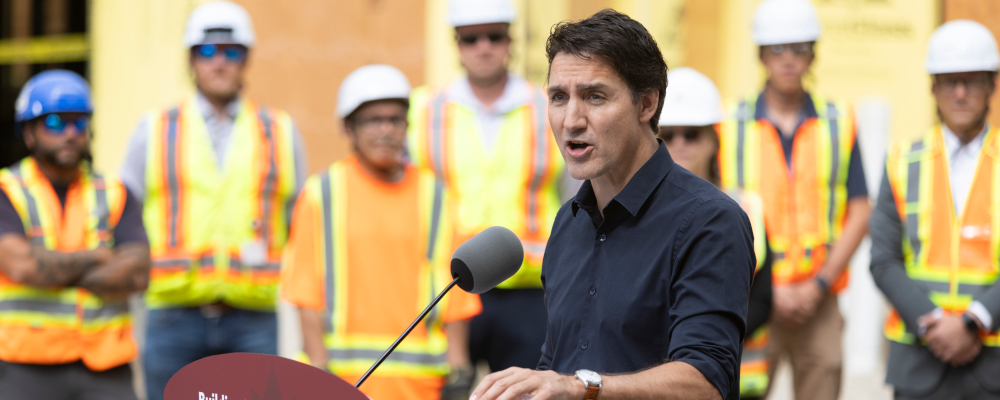Housing policy has taken federal politics by storm. Until recently, housing policy was largely thought of as a municipal issue. As the housing crisis has spilled out of Toronto and Vancouver into surrounding communities, then much of the rest of the country, it’s become not just an issue, but the issue for the provinces and now the federal government.
Sitting governments got caught flat-footed by this shift. Everyone knew housing was bad, but up until a few years ago, the idea of provincial governments intervening in local zoning issues was taboo for all but the most ardent YIMBYs. The notion of federal intervention was even more so. So senior levels of government have been flailing around, trying to figure out something—anything—and preferably without annoying existing homeowners.
It started out with easy but ineffective solutions. Taxes on foreign buyers, subsidies for first-time buyers. Scapegoating and feel-goodery weren’t enough, though. Housing prices kept on climbing as bewildered governments looked for more easy levers to pull. They ran out of those a few years ago, so started to come up with bespoke policies like the First Time Homebuyers Savings Account.1Recently governments in Ontario, B.C., and Nova Scotia, among others, have started taking concrete actions to boost housing construction. But it hasn’t been enough.
Political parties and analysts from across the spectrum agree that we need to double housing starts. That takes more than a duplex here and there. That means allowing multiplexes in most places, and apartments in a lot of places, rather than a few designated areas. Municipal governments have been unwilling to take these steps since they represent existing and not prospective future residents. This is why upper levels of government need to step in.
The Conservative Party, to their credit, was ahead of the Liberals and New Democrats on this. Erin O’Toole’s team had one big, very good idea: if the feds are going to pay for local infrastructure, they should put strings on those transfers. If you want money for public transit, allow more housing. It’s a blunt tool, but one that could actually move the needle.
While Erin O’Toole’s time in politics has come and gone, his successor saw the appeal of this approach. Pierre Poilievre, after all, likes to present himself as a commonsense guy who will cut through the nonsense and get stuff done. The idea of using fiscal transfers as a stick to bonk uncooperative municipalities over the head with is a perfect fit for his style. So he’s not only kept the policy, he’s made it one of his signature issues.
The Trudeau government has been trying to maintain a more cooperative approach. The prime minister has accused the Conservative Party of wanting to bully municipalities—a characterization I’m sure Mr. Poilievre loves. Their solution was to reach for a carrot rather than a stick. The Housing Accelerator Fund (HAF) is their solution. Rather than withholding existing funds, the HAF will grant municipalities new funding if they meet housing targets.
While superficially the two policies look very different, they’re actually not. Withholding typical infrastructure funding versus determining not to grant funding through a new program is, for all intents and purposes, the same approach. Each requires good behaviour in exchange for funding. One is just more polite than the other and comes with an application form.
My hope was that Liberals would recognize that they can use their carrot like a stick to brandish at non-cooperative municipalities. As a mushy moderate neoliberal who doesn’t much care who forms governments (so long as they’re not literal fascists or communists), I want good public policy from all parties. In fact, I want them competing to outdo each other on housing policy. Recent developments suggest that this may be happening.
The past week reminded me of the opening scene of Stanley Kubrick’s classic 2001: A Space Odyssey. It’s the dawn of man. A group of hominins is driven away from its watering hole by a hostile clan. Some science fiction-y stuff happens that I won’t try to explain, then later one of the hominins is digging through a pile of bones and realizes that he can use them to smash things! You know what they did? They took back their watering hole!
That might not at first sound exactly like what happened this week, but it’s also not entirely different. The Conservative Party wants to win government. They found a weapon with which to take it: housing policy. They looked like they were set to own the housing policy file uncontested—until the new housing minister found his weapon. Not in a pile of bones, but in a pile of paperwork.
Why the HAF matters
The HAF carrot looks a lot like a stick if you look at it the right way. After all, there’s no reason they can’t lean on municipalities to do more after they’ve received their underwhelming submissions. That’s exactly what new housing minister Sean Fraser appears to be doing. He’s wielding the carrot-stick. Sometimes a bone isn’t just a bone. Sometimes a carrot isn’t just a carrot.
This isn’t just theoretical. The recently announced agreement with London, Ontario might have sounded underwhelming. The agreement is expected to lead to an additional 2000 housing units over three years. London’s ten-year housing target is 47,000 units. In other words, 4700 annually. According to a recent report, they’re running about half that rate. So let’s say 2350. Since 2000 doesn’t divide nicely by three, let’s just round the new commitment down to 650 units annually (an increase of about 27 percent). That’s 3000 units annually, or about 64 percent of their target.
Now let’s apply the Conservative plan to London. We’ll start with the same 2350 units and add 15 percent. That’s roughly 353 additional units. That gets us to 2703 units in year one. Now let’s add 15 percent for year two. Through the magic of compound interest, that gives us a higher annual increase (roughly 405 units). Now we’re at 3108 annual units. By year 3, it’s delivering 3573 units. After three years, the CPC plan would hypothetically deliver 9,384 units compared to 9000 from the Liberal plan. The CPC has an edge here, particularly with continued annual 15 percent increases, though both approaches appear to fall well short of London’s targets.
It is, however, possible that the CPC plan would be more effective in certain cities, but less effective overall. For instance, the Conservative plan would apply to 22 cities, while even small municipalities are eligible for the HAF. This gives the LPC leverage over more municipalities. This is crucial, given that growth will have to accelerate in small cities too.
There’s also the question of permanency. The CPC is attempting to label the Liberal plan as bureaucratic. After all, simply imposing targets is more straightforward than dictating terms. However, the challenge is that even if municipalities find ways to meet those targets for a few years, they could be upended by a change of government. Or by a recession, for that matter. It seems doubtful the federal government would withhold infrastructure money if homebuilding declines for reasons outside the hands of municipalities. The Liberal approach, by contrast, has been to get municipalities to agree to liberalize their zoning policies. In other words, they’re permanently hobbling the zoning gatekeepers.2Of course, London could be seen as a one-off thing. Who knows how successful the old carrot-stick will be with bigger municipalities. Municipalities like Calgary, where even Conservative MPs aren’t in agreement over whether they want more or fewer housing gatekeepers. Surely, Calgary City Council isn’t going to bow before the carrot stick, right? Wrong. The mayor of Calgary put out a statement on Twitter, pleading with her colleagues to move forward with a stalled plan to upzone the city to avoid losing out on federal funding. Sure enough, the NIMBYs at Calgary city hall relented. The carrot-stick is no joke!

Removing the HST is a big deal
Then there’s the second, more publicized recent policy change: the decision to remove the HST from purpose-built rental units. This, to put it mildly, is a big deal—especially right now.
Canada’s general housing policy problem is that it isn’t legal to build enough units in enough places. There’s a second, more temporary problem: tightening financial conditions. The rapid increase in interest rates to combat inflation, paired with a very tight labour market, has made building much more expensive. It’s led many builders to consider pausing projects while they wait for costs to come down. Removing the HST can in many cases make the math work. While there are reasonable debates about the tax treatment of housing in general, if we want to prevent a slowdown in housing construction—let alone increase housing starts—we need to ensure that housing development isn’t collateral damage from our inflation fight.
Curiously, while the Liberals plan a clean HST cut for purpose-built rentals, the Conservative Party’s position is that it should only be applied to buildings where the average rental price is below market rate. This is a baffling position. If the Liberals want to cut taxes, surely Conservatives should agree. Particularly when those taxes are levied on something we all agree we need more of. Whatever happened to supply-side economics?
It’s possible that, all told, CPC policy could result in more housing construction than the Liberal plan. That would require more in-depth analysis than you’ll find in a column. But the fact that this isn’t immediately obvious is a problem. It’s hard to be the party of more housing when your plan isn’t an obvious improvement.
Now that the housing minister seems to be walking around, waving his carrot-stick at municipalities and slashing taxes, Poilievre and co. need to find a more intimidating approach. If you’re going to be the bullies, be the bullies!
One last practical consideration. Running around saying we should increase home building by 15 percent might not be such a great idea if Sean Fraser spends the next two years cutting deals with cities that he can credibly claim will result in a greater than 15 percent increase in home construction—which is the case in London. This is more of a marketing concern than a policy concern, but it seems weird to set targets below your opponent’s. If, instead, Poilievre’s plan was explicitly to double housing starts, in line with the broad expert consensus, he can claim to have the more ambitious plan (which, ironically, would be made more feasible by Liberal policy reforms).
Of course, it’s possible that none of this matters. Sometimes governments die of old age. And maybe messaging matters more than policy. But if Conservatives want to keep owning the housing file, which seems to have propelled them into potential majority government territory, they need to swing harder.
Conservatives need to realize that the landscape has changed. For a long time they’ve had the upper hand on the housing file. They, along with their provincial counterparts in Ontario, were the ones who seemed interested in even trying to achieve the cross-partisan consensus of doubling housing starts. Now that the Liberals have woken up, the Conservatives can’t count on cruising along based on platitudes. It’s time to think big or go home.




